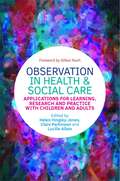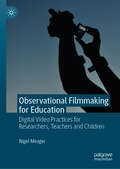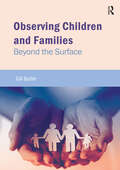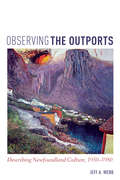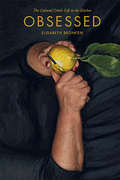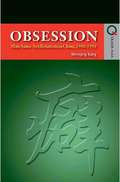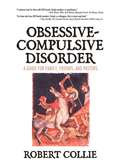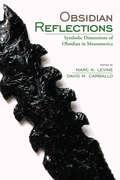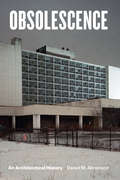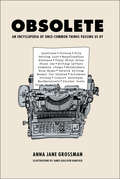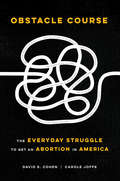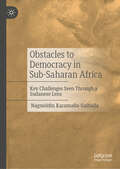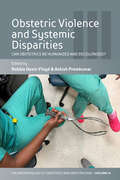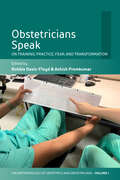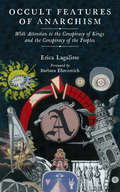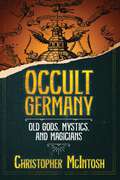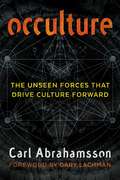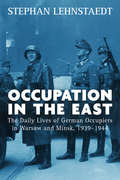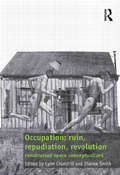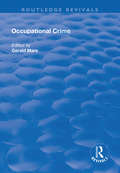- Table View
- List View
Observation in Health and Social Care: Applications for Learning, Research and Practice with Children and Adults
by Lucille Allain Stephen Briggs Claire Kent Gillian Ruch Andrew Cooper Graham Music Helen Hingley-Jones Clare Parkinson Dr Duncan Mclean Dr Pat Cartney Minna DaumExamining and exploring new approaches to therapeutic observation in health and social care, this multidisciplinary guide discusses and analyses its uses in a range of practical contexts with children, families and adults. Developing good observation skills is paramount to sustaining relationships in the challenging settings that health and social care professionals find themselves in. This guide shows how observation is taught, applied in practice, and how it will be returned to throughout professionals' careers. Drawing on psychoanalytic ideas and theories of human development as a base for professional learning, the experienced editors and authors offer theoretically informed models to teach observation skills in professional programmes, helping their readers prepare for successful intervention in any setting.
Observational Filmmaking for Education: Digital Video Practices for Researchers, Teachers and Children (Creativity, Education and the Arts)
by Nigel MeagerThis book places observational filmmaking in the context of the rapidly developing landscape of creativity and arts based research in education. The author uses observational filmmaking as a lens to address debates surrounding video based and arts based research. Utilising the work of Dewey and Deleuze as the theoretical underpinnings of the volume, this is combined with numerous practical examples of observational filmmaking in schools. The author argues that observational video camera and editing techniques combine careful observation with rigorous visual analysis: they place sensory, affectual and aesthetic qualities in experience centre stage. While observational filmmaking in itself has enormous potential as a methodology for education research, it may also become a fulcrum for children’s learning. Children record their experiences in the world around them as they look carefully with a video camera. This pioneering yet practical book will be of interest and value to students and scholars of creativity, learning, and education research methods, as well as constituting a useful guide for teachers, arts practitioners and education policy makers.
Observing Children and Families: Beyond the Surface
by Gill ButlerThis book explains the unique insights that child observation can bring to practice with children and families and helps the reader develop their own skills in this approach.The ability to observe and to process what is seen is crucial in social work with children and families. Yet successive inquiries into child deaths have demonstrated the problems faced by professionals in doing what is superficially a very straightforward task, highlighting the difficulties in seeing, thinking about and developing an understanding of the child’s experience.This book helps readers to develop an understanding of what is entailed in observation, explaining the unique insights that child observation can bring to practice with children and families. By drawing out relevant theoretical concepts it aids their understanding of what they are observing and so helps them to develop their own skills. Key theoretical concepts are brought together from developmental psychology and psychoanalytic thinking in a way that enables practitioners to draw on these to inform and enrich their thinking. Useful case studies are presented which practitioners can relate to their own practice when they are struggling to make sense of difficult situations.
Observing the Outports
by Jeff WebbThe years after Newfoundland's confederation with Canada were ones of rapid social and economic change, as provincial resettlement and industrialization initiatives attempted to transform the lives of rural Newfoundlanders. At Memorial University in St. John's, a new generation of faculty saw the province's transformation as a critical moment. Some hoped to solve the challenges of modernization through their rural research. Others hoped to document the island's "traditional" culture before it disappeared. Between them they created the field of "Newfoundland studies."In Observing the Outports, Jeff A. Webb illustrates how interdisciplinary collaborations among scholars of lexicography, history, folklore, anthropology, sociology, and geography laid the foundation of our understanding of Newfoundland society in an era of modernization. His extensive archival research and oral history interviews illuminate how scholars at Memorial University created an intellectual movement that paralleled the province's cultural revival.
Obsessed: The Cultural Critic’s Life in the Kitchen
by Elisabeth BronfenEven the most brilliant minds have to eat. And for some scholars, food preparation is more than just a chore; it’s a passion. In this unique culinary memoir and cookbook, renowned cultural critic Elisabeth Bronfen tells of her lifelong love affair with cooking and demonstrates what she has learned about creating delicious home meals. She recounts her cherished food memories, from meals eaten at the family table in postwar Germany to dinner parties with friends. Yet, in a thoughtful reflection on the pleasures of cooking for one, she also reveals that some of her favorite meals have been consumed alone. Though it contains more than 250 mouth-watering recipes, Obsessed is anything but a conventional cookbook. As she shares a lifetime of knowledge acquired in the kitchen, Bronfen hopes to empower both novice and experienced home chefs to improvise, giving them hints on how to tweak her recipes to their own tastes. And unlike cookbooks that assume readers have access to an unlimited pantry, this book is grounded in reality, offering practical advice about food storage and reusing leftovers. As Bronfen serves up her personal stories and her culinary wisdom, reading Obsessed is like sitting down to a home-cooked meal with a clever friend.
Obsession: Male Same-Sex Relations in China, 1900-1950
by Wenqing KangThis is the most serious study to date on the topic of male same-sex relations in China during the early twentieth century, illuminating male same-sex relations in many sites: language, translated sexological writings, literary works, tabloid newspapers,and opera. Documenting how nationalism and colonial modernity reconfigured Chinese discourses on sex between men in the early twentieth century, Wenqing Kang has amassed a wealth of material previously overlooked by scholars, such as the entertainment news and opinion pieces related to same-sex relations published in the tabloid press.
Obsessive-Compulsive Disorder: A Guide for Family, Friends, and Pastors
by Robert CollieExamine the fourth largest mental health problem in America-OCD-and how YOU can help!Since obsessive-compulsive disorder affects 2.5% of the world population, someone you know is likely to have this disorder. Obsessive-Compulsive Disorder: A Guide for Family, Friends, and Pastors is a handy "physician's assistant" that not only provides a fresh overview of OCD but also focuses on the issue of scrupulosity-obsessive-compulsive anxiety over scruples in self and others-as a religious issue. Written by a pastoral counselor who is also a clinical social worker, this book will help you gain insight into the psychological and neurological dimensions of the disorder, the problems of those suffering from OCD, and the development of support groups. Written with extensive knowledge and deep compassion, Obsessive-Compulsive Disorder: A Guide for Family, Friends, and Pastors presents the latest information available on OCD and its effects upon sufferers and their personal relationships. The information is discussed in both pastoral as well as therapeutic aspects, explaining OCD in the brain, then continuing with ways to help a sufferer manage the conflict. Special attention is paid to the issue of scrupulosity-"seeing sin where there is no sin"-which is especially symptomatic for many Roman Catholics, Orthodox Jews, and Orthodox Muslims. Filled with insightful case studies and a useful bibliography, this book helps you understand OCD from all sides while giving effective strategies for individual and group therapy. In Obsessive-Compulsive Disorder: A Guide for Family, Friends, and Pastors you will find: answers to the most frequently asked questions detailed explanations of terms insightful information on pastoral caring an in-depth exploration of scrupulosity helpful information on trichotillomania (hair pulling), kleptomania (stealing), Tourette&’s syndrome, body dysmorphoric disorder (hatred of a particular body part), and hypochondriasis case studies highlighting personal and relationship issues resources for developing support groups resources for further information on OCD A Guide for Family, Friends, and Pastors is for pastors, pastoral counselors, chaplains, lay ministries, social workers, psychiatric nurses, marriage counselors, and for anyone who cares about someone with OCD.
Obshchestvennost’ and Civic Agency in Late Imperial and Soviet Russia: Interface between State and Society
by Yasuhiro MatsuiIn modernizing Russia, obshchestvennost', an indigenous Russian word, began functioning as a term to illuminate newly emerging active parts of society and their public identities. This volume approaches various phenomena associated with the term throughout the revolution, examining it in the context of the press, public opinion, and activists.
Obsidian Reflections
by David M. Carballo Marc N. LevineDeparting from the political economy perspective taken by the vast majority of volumes devoted to Mesoamerican obsidian, Obsidian Reflections is an examination of obsidian's sociocultural dimensions--particularly in regard to Mesoamerican world view, religion, and belief systems. Exploring the materiality of this volcanic glass rather than only its functionality, this book considers the interplay among people, obsidian, and meaning and how these relationships shaped patterns of procurement, exchange, and use. An international group of scholars hailing from Belize, France, Japan, Mexico, and the United States provides a variety of case studies from Mexico, Guatemala, Belize, and Honduras. The authors draw on archaeological, iconographic, ethnographic, and ethnohistoric data to examine obsidian as a touchstone for cultural meaning, including references to sacrificial precepts, powerful deities, landscape, warfare, social relations, and fertility.Obsidian Reflections underscores the necessity of understanding obsidian from within its cultural context--the perspective of the indigenous people of Mesoamerica. It will be of great interest to Mesoamericanists as well as students and scholars of lithic studies and material culture.
Obsidian Reflections: Symbolic Dimensions of Obsidian in Mesoamerica
by Marc N. Levine and David M. CarballoDeparting from the political economy perspective taken by the vast majority of volumes devoted to Mesoamerican obsidian, Obsidian Reflections is an examination of obsidian's sociocultural dimensions—particularly in regard to Mesoamerican world view, religion, and belief systems. Exploring the materiality of this volcanic glass rather than only its functionality, this book considers the interplay among people, obsidian, and meaning and how these relationships shaped patterns of procurement, exchange, and use. An international group of scholars hailing from Belize, France, Japan, Mexico, and the United States provides a variety of case studies from Mexico, Guatemala, Belize, and Honduras. The authors draw on archaeological, iconographic, ethnographic, and ethnohistoric data to examine obsidian as a touchstone for cultural meaning, including references to sacrificial precepts, powerful deities, landscape, warfare, social relations, and fertility. Obsidian Reflections underscores the necessity of understanding obsidian from within its cultural context—the perspective of the indigenous people of Mesoamerica. It will be of great interest to Mesoamericanists as well as students and scholars of lithic studies and material culture.
Obsolescence: An Architectural History
by Daniel M. AbramsonIn our architectural pursuits, we often seem to be in search of something newer, grander, or more efficient—and this phenomenon is not novel. In the spring of 1910 hundreds of workers labored day and night to demolish the Gillender Building in New York, once the loftiest office tower in the world, in order to make way for a taller skyscraper. The New York Times puzzled over those who would sacrifice the thirteen-year-old structure, “as ruthlessly as though it were some ancient shack.” In New York alone, the Gillender joined the original Grand Central Terminal, the Plaza Hotel, the Western Union Building, and the Tower Building on the list of just one generation’s razed metropolitan monuments. In the innovative and wide-ranging Obsolescence, Daniel M. Abramson investigates this notion of architectural expendability and the logic by which buildings lose their value and utility. The idea that the new necessarily outperforms and makes superfluous the old, Abramson argues, helps people come to terms with modernity and capitalism’s fast-paced change. Obsolescence, then, gives an unsettling experience purpose and meaning. Belief in obsolescence, as Abramson shows, also profoundly affects architectural design. In the 1960s, many architects worldwide accepted the inevitability of obsolescence, experimenting with flexible, modular designs, from open-plan schools, offices, labs, and museums to vast megastructural frames and indeterminate building complexes. Some architects went so far as to embrace obsolescence’s liberating promise to cast aside convention and habit, envisioning expendable short-life buildings that embodied human choice and freedom. Others, we learn, were horrified by the implications of this ephemerality and waste, and their resistance eventually set the stage for our turn to sustainability—the conservation rather than disposal of resources. Abramson’s fascinating tour of our idea of obsolescence culminates in an assessment of recent manifestations of sustainability, from adaptive reuse and historic preservation to postmodernism and green design, which all struggle to comprehend and manage the changes that challenge us on all sides.
Obsolete: An Encyclopedia of Once-Common Things Passing Us By
by Anna Jane GrossmanA cultural catalog of everyday things rapidly turning into rarities—from landlines to laugh tracks. So many things have disappeared from our day-to-day world, or are on the verge of vanishing. Some we may already think of as ancient relics, like typewriters (and their accompanying bottles of correction fluid). Others seem like they were here just yesterday, like boom boxes and CDs. We may feel fond nostalgia for certain items of yore: encyclopedias, newspapers, lighthouses. Other items, like MSG, not so much. But as the pace of change keeps accelerating, it&’s worth taking a moment to mark the passing of the objects of our lives, from passbooks and pay phones to secretaries and skate keys. And to reflect on certain endangered phenomena that may be worth trying to hold on to—like privacy, or cash. This thoughtful alphabetized compendium invites us to take a look at the many things, ideas, and behaviors that have gone the way of the subway token—and to reflect on what is ephemeral, and what is truly timeless.
Obstacle Course: The Everyday Struggle to Get an Abortion in America
by Carole Joffe David S. CohenIt seems unthinkable that citizens of one of the most powerful nations in the world must risk their lives and livelihoods in the search for access to necessary health care. And yet it is no surprise that in many places throughout the United States, getting an abortion can be a monumental challenge. Anti-choice politicians and activists have worked tirelessly to impose needless restrictions on this straightforward medical procedure that, at best, delay it and, at worst, create medical risks and deny women their constitutionally protected right to choose. Obstacle Course tells the story of abortion in America, capturing a disturbing reality of insurmountable barriers people face when trying to exercise their legal rights to medical services. Authors David S. Cohen and Carole Joffe lay bare the often arduous and unnecessarily burdensome process of terminating a pregnancy: the sabotaged decision-making, clinics in remote locations, insurance bans, harassing protesters, forced ultrasounds and dishonest medical information, arbitrary waiting periods, and unjustified procedure limitations. Based on patients’ stories as well as interviews with abortion providers and allies from every state in the country, Obstacle Course reveals the unstoppable determination required of women in the pursuit of reproductive autonomy as well as the incredible commitment of abortion providers. Without the efforts of an unheralded army of medical professionals, clinic administrators, counselors, activists, and volunteers, what is a legal right would be meaningless for the almost one million people per year who get abortions. There is a better way—treating abortion like any other form of health care—but the United States is a long way from that ideal.
Obstacles to Democracy in Sub-Saharan Africa: Key Challenges Seen Through a Sudanese Lens
by Nagmeldin Karamalla-GaiballaThis book analyses the failure factors of democratic experiences in Sub-Saharan Africa, focusing on the Republic of Sudan. Through historical comparisons, it aims to further our understanding of democratic African state formation in the aftermath of colonialism, the impact of military coups on undermining democracy in sub-Saharan Africa, the formation and structuring of political parties in the region, and the failures and successes of popular revolutions in establishing good governance. To do so, the author weaves a portrait of the current state of democratic governance in Sudan and the broader sub-Saharan region by threading primary data analysis, such as expert interviews and surveyed participants of the Sudanese revolution, along with their personal reflections and observations on life lived in Sudan. Arguing that the nation is in a state of political crisis, the book posits that Sudan marks a potent example of failing democratic institutions in sub-Saharan Africa in the post-colonial era.
Obstetric Violence and Systemic Disparities: Can Obstetrics Be Humanized and Decolonized? (The Anthropology of Obstetrics and Obstetricians: The Practice, Maintenance, and Reproduction of a Biomedical Profession #3)
by Robbie Davis-Floyd and Ashish PremkumarThe final volume in this landmark 3-volume series The Anthropology of Obstetrics and Obstetricians: The Practice, Maintenance, and Reproduction of a Biomedical Profession looks at the challenges, and even violence, that obstetricians face across the world. Part I of this volume addresses obstetric violence and systemic racial, ethnic, gendered, and socio-structural disparities in obstetricians’ practices in the Dominican Republic, Mexico, Peru, and the US. Part II addresses decolonizing and humanizing obstetric training and practice in the UK, Russia, Brazil, New Zealand, and the US. Part 3 presents the ethnographic challenges that the chapter authors in Volumes II and III of this series faced in finding, surveying, interviewing, and observing obstetricians in various countries. This book is a must-read for students, social scientists, and all maternity care practitioners who seek to understand the diverse challenges that obstetricians must overcome. An excerpt: In our Series Overview in Volume 1, we asked the question, “Can a book create a field?” and answered that question with a resounding “Yes!” … For us, the official creation of the field of the Anthropology of Obstetrics and Obstetricians has taken not one, but the 3 volumes that constitute this Book Series.
Obstetricians Speak: On Training, Practice, Fear, and Transformation (The Anthropology of Obstetrics and Obstetricians: The Practice, Maintenance, and Reproduction of a Biomedical Profession #1)
by Robbie Davis-Floyd and Ashish PremkumarFor the first time ever in a social science work, obstetricians tell their own stories of training, practice, fear, and transformation in this the first of the 3-volume series The Anthropology of Obstetrics and Obstetricians: The Practice, Maintenance, and Reproduction of a Biomedical Profession. These stories range from those of abortion providers to those of maternal-fetal medicine specialists. Several chapters tell the stories of obstetricians who have made paradigm shifts from technocratic to humanistic practices, the benefits and joys of these paradigm shifts, and the ostracism, bullying, and outright persecution these humanistic obstetricians have suffered. This book is a must-read for students, social scientists, and all maternity care practitioners who seek to understand the ideologies and motives of individual obstetricians. An excerpt from Kathleen Hanlon-Lundberg’s chapter: Largely maligned in reproductive anthropological literature as callous—if not brutal—self-serving effectors of the over-medicalization of childbirth, most obstetricians whom I know and have worked with are devoted to providing respectful, individualized care to their patients.
Obstetrics and Gynecology in Low-Resource Settings
by Nawal M. NourObstetrics and Gynecology in Low-Resource Settings provides practical guidelines for ensuring quality care to women in locations where facilities are inadequate, equipment and medications are in short supply, and medical staff are few. This reference will be an essential companion to health care providers throughout the world.
Obstinate Hebrews: Representations of Jews in France, 1715-1815
by Ronald SchechterA path-breaking study of the Jews in France from the time of the philosophies through the Revolution and up to Napoleon. Examines how Jews were thought of during this time, by both French writers and the Jews themselves.
Occult Features of Anarchism: With Attention to the Conspiracy of Kings and the Conspiracy of the Peoples (KAIROS)
by Barbara Ehrenreich Erica LagalisseIn the nineteenth century anarchists were accused of conspiracy by governments afraid of revolution, but in the current century various "conspiracy theories" suggest that anarchists are controlled by government itself. The Illuminati were a network of intellectuals who argued for self-government and against private property, yet the public is now often told that they were (and are) the very group that controls governments and defends private property around the world. Intervening in such misinformation, Lagalisse works with primary and secondary sources in multiple languages to set straight the history of the Left and illustrate the actual relationship between revolutionism, pantheistic occult philosophy, and the clandestine fraternity. Exploring hidden correspondences between anarchism, Renaissance magic, and New Age movements, Lagalisse also advances critical scholarship regarding leftist attachments to secular politics. Inspired by anthropological fieldwork within today's anarchist movements, her essay challenges anarchist atheism insofar as it poses practical challenges for coalition politics in today's world. Studying anarchism as a historical object, Occult Features of Anarchism also shows how the development of leftist theory and practice within clandestine masculine public spheres continues to inform contemporary anarchist understandings of the "political," in which men's oppression by the state becomes the prototype for power in general. Readers behold how gender and religion become privatized in radical counterculture, a historical process intimately linked to the privatization of gender and religion by the modern nation-state.
Occult Germany: Old Gods, Mystics, and Magicians
by Christopher McIntosh• Examines the survival and revival of the old pre-Christian gods, investigates prehistoric sacred sites, and reveals ancient shamanic traditions • Looks at Rosicrucianism and the distinctive Germanic forms of astrology, alchemy, and the Kabbalah • Discusses German poets, philosophers, and mystics, such as Dr. Johann Faust, Wolfram von Eschenbach, Meister Eckhart, Hildegard of Bingen, and Jakob Boehme No country is richer in occult and esoteric traditions than Germany. In this magical journey through the inner history of Deutschland, Christopher McIntosh explores many of these traditions from prehistory to the 21st century. Recounting the longstanding magical tradition of Germany, McIntosh investigates the numerous prehistoric sacred sites that point to a nearly-forgotten ancient shamanic civilization. He examines the survival and revival of the old pre-Christian gods in folklore, customs, and practices as well as witchcraft. He looks at Germany&’s rich and many-faceted spiritual heritage and explores Christian mysticism and theosophy as exemplified by Meister Eckhart, Hildegard of Bingen, and Jakob Boehme. Examining Rosicrucianism, which originated in Germany, the author also looks at other secret societies that flourished in Germany such as speculative Freemasonry, the Fraternitas Saturni, and the Golden and Rosy Cross. He explores how the Church sought to stamp out the old gods and pagan beliefs, as well as how periods of the Church&’s heaviest oppression produced immortal poets, philosophers, theologians, artists, and mystics. He examines the distinctive forms adopted by astrology, alchemy, and the Kabbalah in Germany as well as the esoteric influences on Romanticism. Exploring more recent centuries, the author looks at the Nordic revival in the 19th century and the influence of Theosophy and the movements that grew out of it, such as Steiner&’s Anthroposophy. Examining the esoteric traditions of the 20th century, he looks at the work of neo-Nordic occultists and esoteric writers like Meyrink and Hesse. He explores certain occult aspects of the Third Reich, which resulted in a backlash against the occult. He also looks at modern occult practices and the rise of neopaganism. Revealing both the enlightened and the dark sides of occult Germany, the author shows how this country has long been a cauldron in which esoteric ideas have flourished, spread, been condemned, and lauded, leaving an enduring mark.
Occulture: The Unseen Forces That Drive Culture Forward
by Gary Lachman Carl AbrahamssonExplores the role of magic and the occult in art and culture from ancient times to today • Examines key figures behind esoteric cultural developments, such as Carl Jung, Anton LaVey, Paul Bowles, Aleister Crowley, and Rudolf Steiner • Explores the history of magic as a source of genuine counter culture and compares it with our contemporary soulless, digital monoculture • Reveals how the magic of art can be restored if art is employed as a means rather than an end and offers strategies to rekindle intuitive creativity Art, magic, and the occult have been intimately linked since our prehistoric ancestors created the first cave paintings some 50,000 years ago. As civilizations developed, these esoteric forces continued to drive culture forward, both visibly and behind the scenes, from the Hermetic ideas of the Renaissance, to the ethereal worlds of 19th century Symbolism, to the occult interests of the Surrealists. In this deep exploration of “occulture”--the liminal space where art and magic meet--Carl Abrahamsson reveals the integral role played by magic and occultism in the development of culture throughout history as well as their relevance to the continuing survival of art and creativity. Blending magical history and esoteric philosophy with his more than 30 years’ experience in occult movements, Abrahamsson looks at the phenomena and people who have been seminal in modern esoteric developments, including Carl Jung, Anton LaVey, Paul Bowles, Aleister Crowley, and Rudolf Steiner. Showing how art and magic were initially one and the same, the author explores the history of magic as a source of genuine counter culture and compares it with our contemporary soulless, digital monoculture. He reveals how the magic of art can be restored if art is employed as a means rather than an end--if it is intense, emotional, violent, and expressive--and offers strategies for creating freely, magically, even spontaneously, with intent unfettered by the whims of trends, a creative practice akin to chaos magick that assists both creators and spectators to live with meaning. He also looks at intuition and creativity as the cornerstones of genuine individuation, explaining how insights and illuminations seldom come in collective forms. Exploring magical philosophy, occult history, the arts, psychology, and the colorful grey areas in between, Abrahamsson reveals the culturally and magically transformative role of art and the ways the occult continues to transform culture to this day.
Occupation Diaries
by Raja ShehadehIt is often the smallest details of daily life that tell us the most. And so it is under occupation in Palestine. What most of us take for granted has to be carefully thought about and planned for: When will the post be allowed to get through? Will there be enough water for the bath tonight? How shall I get rid of the rubbish collecting outside? How much time should I allow for the journey to visit my cousin, going through checkpoints? And big questions too: Is working with left-wing Israelis collaborating or not? What affect will the Arab Spring have on the future of Palestine? What can anyone do to bring about change? Are any of life's pleasures untouched by politics?
Occupation in the East: The Daily Lives of German Occupiers in Warsaw and Minsk, 1939-1944
by Stephan LehnstaedtFollowing their occupation by the Third Reich, Warsaw and Minsk became home to tens of thousands of Germans. In this exhaustive study, Stephan Lehnstaedt provides a nuanced, eye-opening portrait of the lives of these men and women, who constituted a surprisingly diverse population—including everyone from SS officers to civil servants, as well as ethnically German city residents—united in its self-conception as a “master race.” Even as they acclimated to the daily routines and tedium of life in the East, many Germans engaged in acts of shocking brutality against Poles, Belarusians, and Jews, while social conditions became increasingly conducive to systematic mass murder.
Occupation: constructed space conceptualized
by Dianne Smith Lynn ChurchillBringing together an international range of contributors from the fields of practice, theory and history, this book takes a fresh look at occupation. It argues that occupation is a prospect that begins with ruin--a residue from the past, an implied or even a resounding presence of something previous that holds the potential for transformation. This prospect invites us to repudiate, re-imagine and re-define lived space, thereby asserting occupation as an act of revolution. Authors drawn from the fields of architecture, urbanism, interior architecture, dance dramaturgy, art history, design and visual arts, cultural studies and media studies provide a unique, holistic view of occupation, examining topics such as: the authority of architecture; architecture as an act of revolution; women in hypersexual space; occupation as a serialized act of ruin; and the definition of space as repudiation. They discuss how acts that re-invent territory and/or shift boundaries--psychological, social and physical--affect identity and demonstrate possession. This theme of occupation is significant and topical at a time of radical flux, generated by the proliferation of hypermedia, and also by the dramatically shifting environmental, political and economic context of this era. The book concludes by asserting that it is through occupation (private and public: real, virtual, remembered, re-invented) that we appear or disappear as the individual or collective self, because the spaces we construct assert particular agendas which we may either contest or live in accord with.
Occupational Crime
by Gerald MarsThis title was first publishde in 2001. Occupational crime is found in the whole range of occupations and at all levels. Despite the fact that activities are widespread and well known, the area is blurred by contradictory perceptions, denials and arguments over definition. This volume presents influential essays on the topic.
